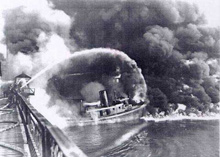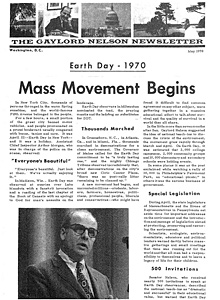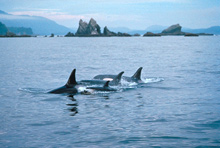Earth Day 1970
- Background and Impetus
- Grassroots Activism
- Formation of NOAA
- Legislative Momentum
- New Roles for NOAA
Background and Impetus

Firefighters battle a fire on Ohio's Cuyahoga River in 1952. The 1969 blaze, one of nine on the river since 1868, came at a time of increasing environmental awareness and symbolized years of environmental neglect. This, in turn, helped spur grassroots activism that resulted in a wave of federal legislation devoted to clean air, clean water, and natural resource protection. Click image for larger view and credit.
On June 22, 1969, the Cuyahoga River on the southern shores of Lake Erie caught fire as oil, chemicals, and other materials, which had oozed into the lake, somehow ignited. The fire captured national attention and made the people of the United States aware of the many insults that had been heaped upon the environment of our nation and of our planet. It also helped lay the foundation of NOAA's major coastal resource management responsibilites and usher in the environmental protection or “green” side of NOAA.
As a result of the Cuyahoga River fire and other horrendous environmental insults–the decline of the bald eagle from the pesticide DDT, whales hunted to near extinction, and the Santa Barbara oil spill–Wisconsin Senator Gaylord Nelson (1916-2005) began planning in September 1969 for an environmental teach-in known as Earth Day. On November 30, 1969, Gladwin Hill of the New York Times reported:
"Rising concern about the environmental crisis is sweeping the nation's campuses with an intensity that may be on its way to eclipsing student discontent over the war in Vietnam...a national day of observance of environmental problems...is being planned for next spring...when a nationwide environmental 'teach- in'...coordinated from the office of Senator Gaylord Nelson is planned....”
Grassroots Environmental Activism

Conceived as an environmental teach-in by Wisconsin Senator Gaylord Nelson, nearly 10 percent of the nation's population participated in the first Earth Day. Nelson, shown above in his May 1970 newsletter, received nearly 500 invitations to speak at various Earth Day events. Click image for larger view and image credit.
Earth Day took place on April 22, 1970. It was spectacularly successful, achieving grassroots concern for environmental problems facing the nation. More than 2,000 colleges and universities, over 10,000 high schools and grade schools, and 20 million citizens participated, nearly ten percent of the U.S. population at that time. American Heritage (October 1993) magazine referred to this first Earth Day as “one of the most remarkable happenings in the history of democracy….”
This vast outpouring of support for the environment marked the day that the political system in the United States truly recognized that caring for the environment and accepting stewardship responsibility for its resources was the hallmark of a great nation. This grassroots political movement helped establish a political climate conducive to forming both the National Oceanic and Atmospheric Administration and the Environmental Protection Agency on October 3, 1970.
Earth Day and the Formation of NOAA
In the months leading up to Earth Day and later to the official government reorganization order that formed NOAA, politicians wrangled and jockeyed among themselves for how best to organize the nation’s federal marine programs. This followed the 1969 Report of the Commission on Marine Science, Engineering and Resources (also known as The Stratton Commission after its chairman, Julius Stratton) entitled Our Nation and the Sea that recommended NOAA be created. Initially, the administration did not favor the recommendation. However, a concerted effort by influential senators convinced President Nixon of the need to consolidate the nation’s marine agencies. Nixon issued the plan to establish NOAA on July 9, 1970, less than three months following Earth Day.
In the order establishing NOAA, President Nixon, recognizing the need for marine resource protection, declared:
“The oceans and the atmosphere are interacting parts of the total envrionmental system upon which we depend not only for the quality of our lives, but for life itself.
“We face immediate and compelling needs for better protection of life and property from natural hazards, and for a better understanding of the total environment–an understanding which will enable us more effectively to monitor and predict its actions, and ultimately, perhaps to exercise some degree of control over them.”
It is hard to imagine that the message of grassroots concern for the environment established on Earth Day was far from the minds elected officials who were responsible for the nation's natural resource agencies.
Legislative Momentum following Earth Day

Killer whales in the Olympic Coast National Marine Sanctuary. A flood of environmental legislation followed in the footsteps of the first Earth Day, including the Marine Protection, Research, and Sanctuaries Act and the Marine Mammal Protection Act, two linchpins of NOAA's coastal resource management responsibilities. Click image for larger view.
In the next ten years, a flood of environmental legislation followed on the footsteps of this first Earth Day including:
- Clean Air Act
- Water Quality Improvement Act
- Water Pollution and Control Act Amendments
- Resource Recovery Act
- Resource Conservation and Recovery Act
- Toxic Substances Control Act
- Occupational Safety and Health Act
- Federal Environmental Pesticide Control Act
- Safe Drinking Water Act
- Federal Land Policy and Management Act
- Surface Mining Control and Reclamation Act
Five other laws, siginficantly enhancing the nation’s ability to protect its marine environment, placed new and strengthened management responsibilities directly on NOAA’s doorstep as they rode in on the era’s wave of enthusiasm for environmental protection. They were:
- Coastal Zone Management Act
- Marine Mammal Protection Act
- Marine Protection, Research, and Sanctuaries Act
- Endangered Species Act
- Fishery Conservation and Management Act
New Roles for NOAA
With responsibility for carrying out these laws, NOAA was no longer limited to the extremely important, but less controversial work of scientific research, observation, and forecasting. NOAA now faced the responsiblities of regulating large numbers of fishery stocks; accommodating multiple and sometime conflicting uses of the ocean within national marine sanctuaries; evaluating, issuing, or denying requests for taking or using marine mammals; protecting endangered species; and assessing coastal states’ ability to enforce natural resource laws in order to manage state coastal areas. In the span of five years, NOAA’s new roles and responsibilities made it part of the “green” revolution brought on by the environmental activism of the 1960s that culminated on April 22, 1970, the first Earth Day.
The first Earth Day marked the day that our nation accepted responsibility for our environment; the outpouring of public sentiment in support of protection and stewardship of our environment significantly influenced our political system. Earth Day has continued every year since as an icon of the movement to monitor, protect, and restore our environment. As such, NOAA has been and continues to be guided and influenced by the spirit and philosophy of the first Earth Day.










